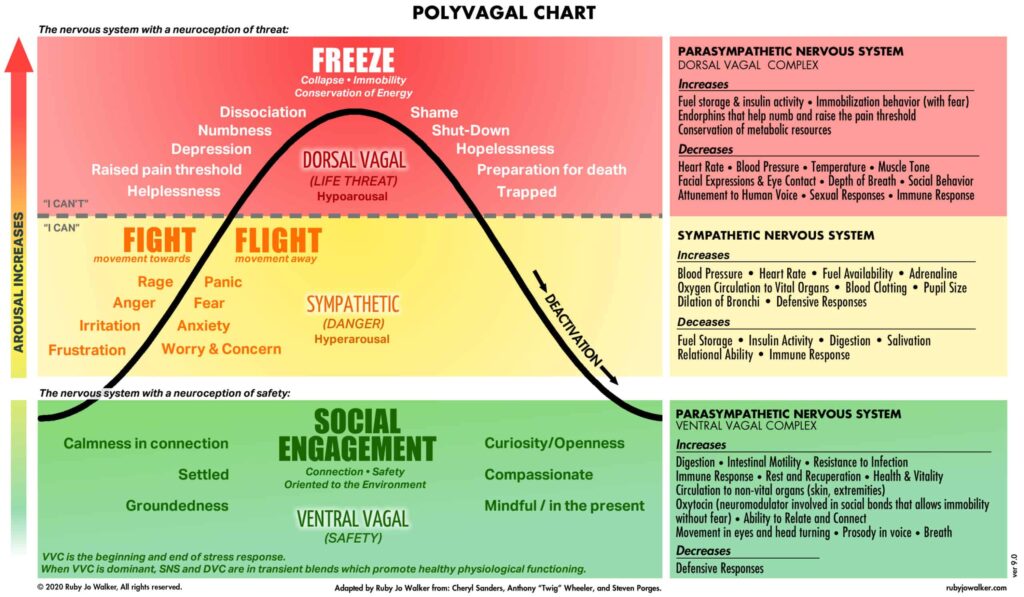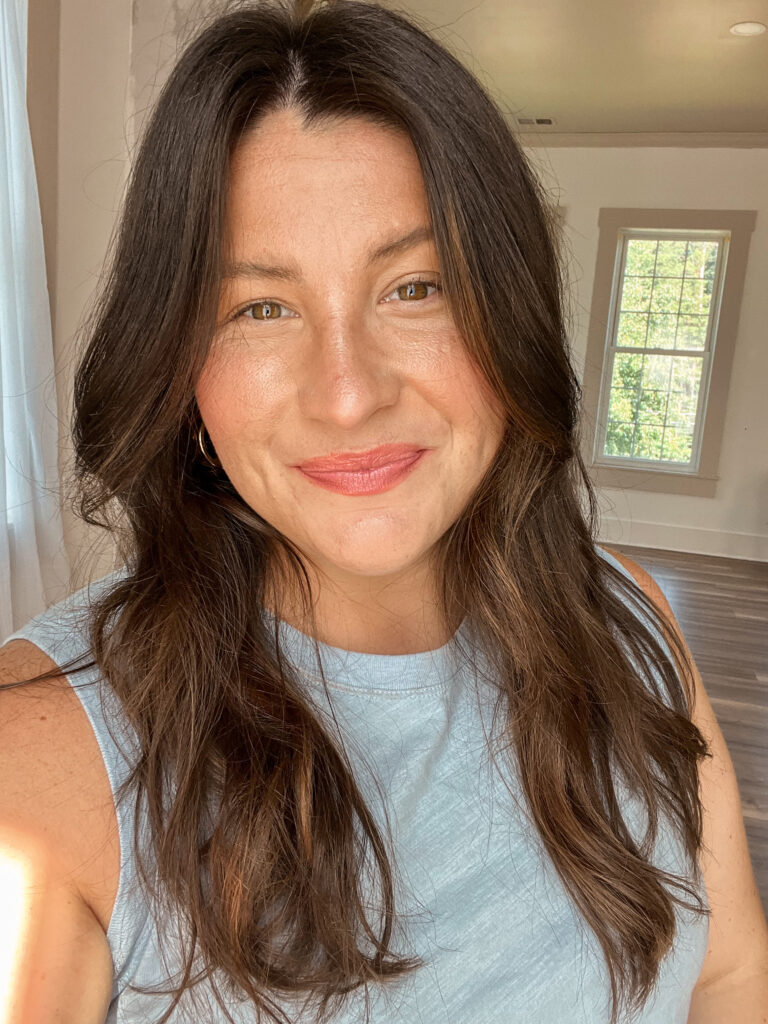Polyvagal Theory in Emotionally Abusive Relationships: Understanding the Impact

Emotional abuse can take many forms, often leaving deep psychological scars for those who experience it. Understanding these emotionally abusive interactions through the lens of Polyvagal Theory offers valuable insights into how individuals respond, and the why behind it. When you are able to start to acknowledge the abuse and the way that you react to it, that is when you can begin to heal.
What is Polyvagal Theory?
Polyvagal Theory is a way of explaining the connection between emotional regulation, social connection, and human fear responses. The key is in – you guessed it: the vagus nerve. The vagus nerve has two branches: the ventral vagal complex and the dorsal vagal complex. The ventral vagus is often associated with safety, social engagement, and calmness, while the dorsal vagus is linked to shutdown and or dissociation. This theory suggests that our physiological responses are directly tied to our emotional experiences, determining how we respond to the environment around us (whether we are safe or in danger).

The 3 States of the Vagus Nerve
- Ventral Vagal State: I like to call this our “green state” or “rest and digest”. This is when we experience a sense of safety, connection, and calm. Otherwise known as “engagement,” particularly in positive social interactions and effective communication. Individuals in this state are open to relationships and can express their needs and desires without fear.
- Sympathetic State: I call this our “yellow zone.” In this state, the body prepares for fight or flight. Individuals experience heightened arousal and anxiety, which can lead to aggressive or defensive behaviors. Relationships can become confrontational, and healthy emotional expression may be limited to anger or frustration.
- Dorsal Vagal State: Our “red zone”. This state occurs in response to extreme stress or threat. It may cause individuals to experience feelings of dissociation, withdrawal, or numbing. In abusive relationships, this state may lead victims to disconnect emotionally and physically from their partner and/or reality.
*It can be difficult to grasp this highly clinical concept, so a visual can be so helpful! I recommend this article, which includes a fantastic visual mapping out these 3 states of the Vagus Nerve.
Emotional Abuse and NPD
Often in emotionally abusive relationships, one partner may show traits of Narcissistic Personality Disorder or could qualify for a full diagnosis of NPD. So what is NPD? Narcissistic Personality Disorder is characterized by a pervasive pattern of grandiosity, a need for admiration, and a lack of empathy. Individuals with NPD often engage in manipulative behaviors that can leave their partners feeling invalidated, controlled, and devalued. Some of these behaviors were noted in the previous article, but some other behaviors that are important to note with NPD are:
- Gaslighting: A tactic to distort a person’s reality, making them doubt their memories and perceptions.
- Emotional Blackmail: Using guilt and fear to gain control over their partner’s actions.
- Isolation: Cutting off support systems to enhance dependency.
- Grandiosity and Entitlement: Expecting special treatment and becoming angry when needs are not met.
It is important to note that this is not an exhaustive list of behaviors. It is important to talk to a mental health professional who has experience with NPD if you feel like these could be present in your relationship.
In relationships where one partner displays NPD traits, emotional abuse can intensify dysregulation of the nervous system, pushing victims into states of sympathetic (fight or flight) or dorsal vagal (freeze) responses.
The Interaction of Polyvagal Theory and Emotionally Abusive Relationships
Understanding the dynamics of Polyvagal Theory in relationships involving an individual with NPD can clarify why abuse has such a profound effect on victims:
- Diminished Ventral Vagal Activity: Partners of individuals with NPD often struggle to maintain a rest or digest. The emotional environment created by narcissistic behaviors often leads to feelings of fear, insecurity, and lack of safety, reducing the capacity to engage positively. This can decrease the functionality of your immune system as well as affect your hormones.
- Increased Sympathetic Activation: The constant emotional turmoil typical in relationships with someone with NPD can activate the fight or flight system, making it easier for your body to jump to feelings of anxiety, irritability, and heightened alertness. You may find yourself reacting defensively or aggressively in an attempt to protect yourself, further worsening the conflict.
- Dorsal Vagal Shutdown: In chronic emotionally abusive environments, victims may experience dorsal vagal shutdown (better known as “freezing”), leading to emotional numbness, depression, or dissociation. This withdrawal serves as a coping mechanism, but it often deepens feelings of loneliness and isolation.
Case Example: Emotional Abuse and Polyvagal Responses

Consider the case of Sarah, who has been in a long-term relationship with Mark, who exhibits strong NPD traits. Sarah often feels tense and anxious around Mark, and frequently finds herself in a state of conflict where her feelings are minimized. When she tries to express her needs, Mark reacts with statements that are degrading or shifts the blame onto her. Naturally, this leads to Sarah feeling dysregulated and confused on what is happening around her and within her body.
As the relationship progresses, Sarah finds herself cycling between:
- Hyper-arousal: Heightened anxiety drives her to overanalyze Mark’s moods, constantly looking for the next trigger to avoid.
- Dissociation: Feeling overwhelmed, she disconnects and withdraws during confrontations, retreating into a numb state.
This cycle leaves Sarah feeling trapped in a chaotic emotional landscape, making it difficult to fully understand what is happening in her relationship. She is unable to use the logical part of the brain (her prefrontal cortex) because she is constantly being pushed into her emotional brain (the amygdala) during the flight/flight/freeze episodes. Not only is she not able to conceptualize what is happening in the relationship, but she is also unable to think through what it would look like to leave it. Let alone the feelings of terror that come with that.
4 Ways to Begin Healing from Emotional Abuse
- Recognizing Patterns: Understanding how one’s nervous system responds to emotional abuse is crucial. Acknowledging shifts between sympathetic and dorsal vagal states can help individuals identify their emotional triggers and responses. Working with a therapist can be critical in helping find these patterns.
- Establishing Safety: Cultivating a safe environment is a vital first step toward healing. This may involve seeking therapy, establishing boundaries with the partner, or creating a support network of friends and family who can provide validation and safety.
- Somatic Approaches: Engaging in practices such as mindfulness, breathwork, and grounding techniques can help individuals return to a rest and digest state. These practices enhance emotional regulation and promote feelings of safety and connection.
- Building Resilience: Engaging in activities that foster feelings of self-worth and autonomy can help individuals reclaim their power. This might include pursuing hobbies, setting personal goals, or developing new relationships outside of the abusive partnership.
Healing is Possible
Understanding the connections between Polyvagal Theory and emotionally abusive relationships with partners who have narcissistic traits provides critical insights into the experiences of those affected. By recognizing the physiological and emotional responses triggered by such dynamics, individuals can work towards healing and reclaiming their autonomy. It is vital to create a support system and self care plan where victims feel safe to engage in with others, themselves and the world around them.

In navigating the complexities of emotional abuse and NPD, acknowledging one’s innate physiological responses can foster resilience, allowing individuals to reconnect with their sense of self and begin the healing journey. If this resonates with you, or reminds you of a friend in a similar situation, I would encourage you to look for a therapist who is trained in trauma treatment – a Polyvagal trained therapist isn’t the only way to go, but it would be a great place to start!
Author: Bayleigh Griffith, MACC, LCMHCA

This article is reposted with the express permission of the original publisher, Dwell Ministry PC (www.dwellministry.org/articles), and remains the intellectual property of the original publisher. All rights are reserved.